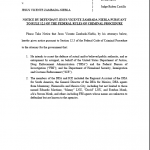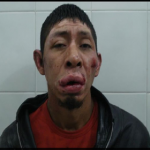Mexico’s Hidden Drug War
May 3rd, 2011 | By Michel Marizco | Category: General News, Organized CrimeTHE BORDER REPORT
The following story was produced for the Fronteras Desk, public radio, Arizona. Click here for the audio version.
Long known as Arizona's beach town, tourists and business owners in Rocky Point, Mexico, say a recent State Department's travel warning about this place is unfair. Victims say otherwise. They say cartel violence in Mexico has quietly crept in and goes mostly unreported. Last year the chief of police of this quiet resort town on the Sea of Cortez was gunned down. Since then, the stories of violence here are barely mentioned. Business owners and the town's mayor prefer to keep it that way. But for people like Veronica, the stories of violence are hard to ignore. Veronica is a waitress in a tourist bar here. She doesn't want her last name used; she's afraid she'll be murdered for talking. She says her boyfriend was a Rocky Point cop kidnapped from their home at gunpoint a few weeks ago. "I have to be careful, I saw the people who did it, so did my son," she says. Police found his body the next day. Noone can agree as to why the killers had ripped his fingernails out and shot him one time. The story barely made the Mexican press and it was never mentioned north of the border. There's other stories. Last week, sources gave a Fronteras Desk reporter a video of a Mexican Marine being accosted in his home by the Rocky Point police chief's bodyguards while the chief stood by watching. In the final moments of the video, his face is shown, beaten. He shot the video on his cellphone. He filed a complaint in court. He was beaten last March. Veronica's boyfriend's was killed in early April. Two weeks later, nearly the entire force held a protest, demanding the chief resign. Rocky Point mayor Alejandro Zepeda dismisses these issues. He's speaking through his translator, Mónica Castro. The mayor says his new chief is staying put. "The commander is ex-military, so he's a little bit more stricter so they have to acknowledge that change and maybe some people don't like the changes but it's gotta be done in order to provide better service for everybody." Over 35,000 people have been killed in Mexico's drug wars since 2006. Fewer than three hundred were Americans. Now The State Department's travel warning cautions visitors to Rocky Point. It's Washington's broadest alert yet. It advises people to stay away from entire states in Mexico and includes small towns like Rocky Point it had never mentioned before.
Steve Holder's been coming to Rocky Point with his friends for nearly 20 years.
"I'm going to Turkey next week and there's a travel warning there too so what can you do," he says as he smokes a cigar and orders another beer on the patio.
No American has been killed in Rocky Point as a result of the drug violence in Mexico. But fear has driven the tourists away. On a beautiful day in April, it takes eight hours to find a single American. Rafael Noriega gave up on American tourists.
The restaurant owner tried running a swank Italian place in the Old Port. Now he caters to the Mexican crowd with cheap, good red wine and five dollar pizzas.
"Only Mexicans now. Mexicans from all over around. There's no Americans, well."
Like the mayor, he says the little bit of violence that hit Rocky Point is the kind of sporadic violence that can hit any town in the world.
"Nothing special. There's not violence in Puerto Peñasco," he pauses. "Not really."
That same afternoon, the Mexican Army storms through downtown.. Fifty-cal rifles are mounted on rotating turrets on the soldiers' Humvee. Those soldiers had just shot a man in a white SUV.
This is the problem with reporting on the violence in this town. Two soldiers threatened to arrest me when I tried to photograph the crime scene. The story didn't appear in the town's two major papers the next morning.
The Mexican Army never admits publicly to the shooting.
Over 35,000 people have been killed in Mexico's drug wars since 2006. Fewer than three hundred were Americans. Now The State Department's travel warning cautions visitors to Rocky Point. It's Washington's broadest alert yet. It advises people to stay away from entire states in Mexico and includes small towns like Rocky Point it had never mentioned before.
Steve Holder's been coming to Rocky Point with his friends for nearly 20 years.
"I'm going to Turkey next week and there's a travel warning there too so what can you do," he says as he smokes a cigar and orders another beer on the patio.
No American has been killed in Rocky Point as a result of the drug violence in Mexico. But fear has driven the tourists away. On a beautiful day in April, it takes eight hours to find a single American. Rafael Noriega gave up on American tourists.
The restaurant owner tried running a swank Italian place in the Old Port. Now he caters to the Mexican crowd with cheap, good red wine and five dollar pizzas.
"Only Mexicans now. Mexicans from all over around. There's no Americans, well."
Like the mayor, he says the little bit of violence that hit Rocky Point is the kind of sporadic violence that can hit any town in the world.
"Nothing special. There's not violence in Puerto Peñasco," he pauses. "Not really."
That same afternoon, the Mexican Army storms through downtown.. Fifty-cal rifles are mounted on rotating turrets on the soldiers' Humvee. Those soldiers had just shot a man in a white SUV.
This is the problem with reporting on the violence in this town. Two soldiers threatened to arrest me when I tried to photograph the crime scene. The story didn't appear in the town's two major papers the next morning.
The Mexican Army never admits publicly to the shooting. 


